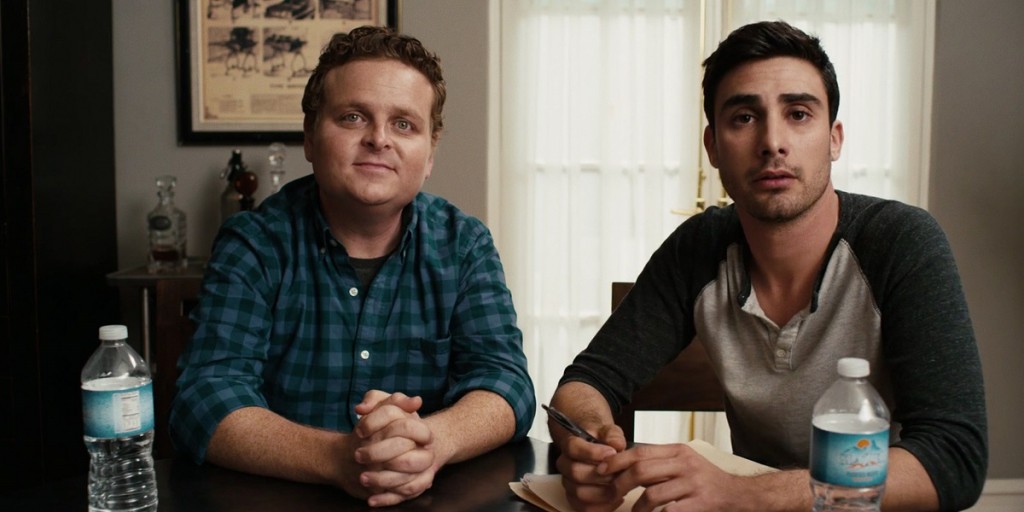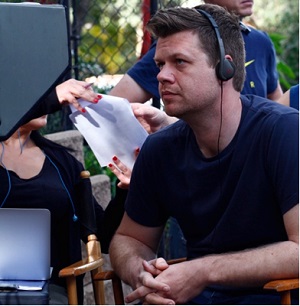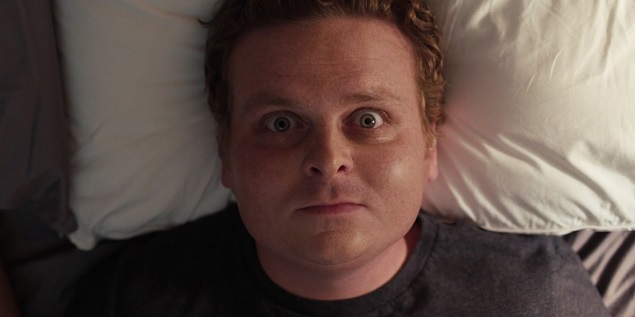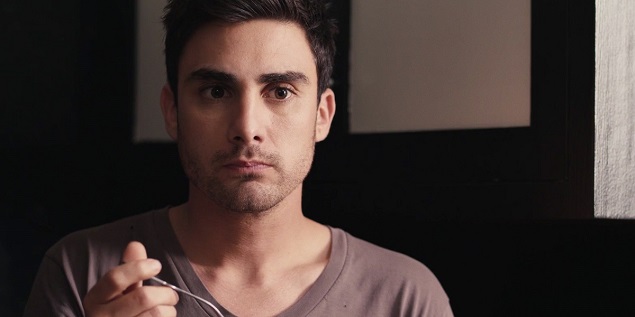Cast and Crew of ‘Bad Roomies’ Talk Tone, Relationships and Independent Filmmaking

Patrick Renna as “Bobby” (left) and Tommy Savas as “Raymond” (right) in Bad Roomies. Photo: Eastside Films.
Friends can be roommates, but roommates can’t always be friends.
For the first feature film of a director who is known mostly for his short film comedies, among them the award-winning short Max and Josh and his YouTube comedy sketches like The Basement and The Online Gamer, it sounds like a simple enough premise.
To the credit of Jason Schnell, his new dark comedy Bad Roomies takes what sounds like a modest story and molds it into something more complex. The film has a unique mix of comedy and drama, thanks to Schnell’s confident direction. But he can’t take all the credit, as it’s also the clever writing of Justin Mooney and the skilled acting and producing by leads Tommy Savas and Patrick Renna that give Bad Roomies its identity.
Bad Roomies tells the story of Raymond (Tommy Savas) and Bobby (Patrick Renna), two lifelong friends who begin a search for a new roommate after losing their previous one. After several painful interviews, they eventually settle on a gorgeous, seemingly innocent woman named Chloe (Annie Monroe). While they get off to a great start, Raymond and Bobby can’t deny the lingering sexual tension with Chloe, and when all three have a drunken sexual encounter at a party, their rocky relationship spirals out of control. So much for roommates being friends…
Schnell, Mooney and Savas all collaborated previously on the popular YouTube sketch comedy channel Reckless Tortuga, where they created series such as Psycho Girlfriend and The Online Gamer. Outside of Tortuga, Savas is best known for an extensive television career, including the role of Xavier in The Sopranos and roles on shows such as Castle, Arrested Development, The Last Ship and State of Affairs, where he is a series regular.
Renna’s acting career includes roles on ER, The X-Files and Boston Legal, but is most fondly remembered for his role on The Sandlot as Hamilton “Ham” Porter, where he became famous for his “You’re killing me, Smalls!” catchphrase.
Friends for 18 years, Renna and Savas worked on Bad Roomies as both actors and producers, which was a first for both of them. Gathering $75,938 from 200 backers on Kickstarter to bring their pet project to life, Renna, Savas, Schnell and Mooney then partnered with The Orchard to distribute the film internationally on various VOD, cable and satellite platforms starting Dec. 1. The whole endeavor was a labor of love between four close friends, whose transition into making their first feature-length film together came with some unique experiences.
Talking about those experiences, Savas, Renna, Mooney and Schnell sat down with GALO and discussed their transition from Internet sketch comedies to film, themes about roommate relationships, balancing comedy and drama, and the differences between independent and studio moviemaking.

Pictured: Jason Schnell. Photo: Eastside Films.
GALO: Jason, how big of a transition was it for you going from directing YouTube sketch comedies to directing a feature film?
Jason Schnell: It was absolutely massive, like a completely different animal. The sheer size and scale, the performance, the tone, it was all extremely difficult going from short to long form content. The thing that got me was managing the tone, since it’s not a broad comedy and not a serious dark movie.
GALO: The movie is being marketed as a dark comedy, but deals with some pretty heavy subject material. What comes to mind is the scene where Bobby (Patrick Renna) and Raymond (Tommy Savas) drunkenly agree to a threesome with Chloe (Annie Monroe). Despite the very serious downward spiral this creates for the characters, the film still keeps a lighthearted tone throughout. What kind of process did you have to undergo to balance that tone and to keep the film from becoming too dark or too comedic? Also, why did you want to focus on such themes?
Justin Mooney: I think that a lot of what I find is going to that dark side. My all-time favorite film is Dr. Strangelove (1964). It’s a comedy and it’s dark, but I find interesting things there. When I see things that are absurd or dark, I find a point of levity or lightness. I had the advantage of writing for actors I knew. I could say something very dark and know the performance, and I knew it wouldn’t be dark. It gave me a range to play with, just a desolate or weird place — that’s where comedy comes out.
GALO: Crowdfunding had a huge hand in getting this movie made. What are your thoughts on crowdfunding as an avenue to fund more creative, original projects, especially in the film industry?
Patrick Renna: Kickstarter was great, and we were very happy to be a part of that experience. We started out doing it, and what we all took from it was [that] it took a lot of work. We had a friend of ours in the Veronica Mars (2014) movie and we thought, ‘Hey, we can do this!’ [But] little did we know, as it involved a lot more work than we [initially] thought. After we reached our goal, it inspired our executive producer to jump on and finish the film. We were able to make the movie for a bit more than we expected.
GALO: Tommy and Patrick, what sort of challenges did you both face while balancing being actors and producers on this film?
Tommy Savas: Quite a challenge — just by being an actor, you get the pleasure of showing up on set and being the character.
Patrick: It was a four man team [Patrick, Tommy, Jason and Justin]. We would shoot 8 to 12 hour days, but before and after shooting, we had meetings as producers, and it was almost a second job. I think the challenges were alleviated by having more onset producers. And when we moved into producer mode, we had pre-production and post-production, but we didn’t have many challenges because we had a great support team.
GALO: The film focuses a lot on the dynamic between your characters Bobby and Ray and how it changes drastically when Chloe moves in. How do you both view the changing relationships in the film, both among yourselves and your relationship with Chloe?
Patrick: It’s such a whirlwind process; you forget what the character’s thinking. Jason helped remind us where we were with the character arc. The dynamic change that Chloe brings is the idea of a beautiful girl, and how the idea of a lovely evening with everyone involved sounds better than what actually happens.
Tommy: It was a very interesting process to figure out. Luckily, we had Jason there to lead us through it. [Raymond’s] not necessarily surprised at first when Bobby has a new person in his environment. He sees a new side of Bobby that he hasn’t seen before. Many friendships go through ups and downs, and when you have a friendship, you go through with it no matter what. It was great having Jason there to say, “This is where Raymond is with his relationship to Bobby.”

Bad Roomies actor/producer Patrick Renna. Photo: Eastside Films.

Bad Roomies actor/producer Tommy Savas. Photo: Eastside Films.
GALO: You did a series of short YouTube sketches (Wake Up Coffee) that sort of introduce us to the film’s characters. How do the shorts provide context for the film’s events, and how do they characterize Bobby and Ray versus what we see in the film?
Jason: When we did those series of shorts, we were still in the process of finishing up the script and finding out where the characters were going. [In the shorts], we learn how they lost their first roommate. The film begins with the roommate leaving, so we wanted to show the backstory of where the characters were before [that]. I think we get more grounded once we get to the feature.
GALO: Compared to a blockbuster film, what would you say is the advantage of doing an independent feature?
Jason: The advantage you have with independent features is [that] you’re telling a different kind of story in a new way. This is a different comedy than what you see normally. We came up with interesting, new avenues of storytelling and ways where the story can go. We tried to make this as entertaining and broad as possible, [to] show audiences something they haven’t seen before. If this was a studio picture, everyone would be holding hands by the third act.
Patrick: It’s nice, everything’s up to you. It’s a little nerve-wracking because if it’s terrible, it’s your fault, but it can also be rewarding. The advantage of a studio picture is a ton of money, which makes things a lot different. [With independent films], the biggest directors, producers, actors, [they] all started here.
Tommy: For me, the best part of independent film as an actor and producer is that you have more opportunities to influence the film — whereas in a studio film, at my level, I have no opportunity to influence it.
GALO: Bobby and Ray have a great friendship running through the film. The scene that comes to my mind is when they’re in bed together discussing Chloe while she’s in the shower. Patrick and Tommy, how did your real life friendship influence this scene and your friendship in the movie in general?
Tommy: Just being friends for so long [and in] doing short films together (doing stuff with Jason, too), it’s beyond easy to do stuff with that — just extremely simple.
Patrick: That’s the director’s favorite scene — right, Jason? Because Tommy and I knew each other so long, the scenes were very fluid. We knew where the other was going before they went there. It’s much easier to bring the comedy out; the way we set it up made it really great. There are a lot of aspects to that scene in particular. The way the camera was set up, it created an atmosphere that was so comedic.
As an actor, there was a sense of the environment [that] was funny. So many things played a part in the humor of it. Plus, my existing friendship with Tommy, the improv we have, we know what the other is thinking and where they’re going. It just makes for a better scene. [With] all four of us being friends, growing up together, knowing each other, [it] made this process doable. That cut out a lot of wasted time because we knew where we wanted to go with the comedy.
GALO: Do you all have other projects planned for this year or the following year, and will you collaborate again on a project in the future?
Jason: We all have things we’re doing, but we’re all focusing on Bad Roomies right now. As far as working together, I think we’d all love to work together again.
Patrick: We definitely had our work cut out for us, and we were lucky to have Orchard for distribution. We were pretty swamped, but we are all looking forward to our next project, Bad Roomies 2: Electric Boogaloo.
GALO: Bad Roomies 2: Electric Boogaloo. That’s funny! Thank you so much for this interview guys, it’s been educational and informative.
Video courtesy of Reckless Tortuga.
“Bad Roomies” is now available on DVD and VOD. For purchasing information, click here.
